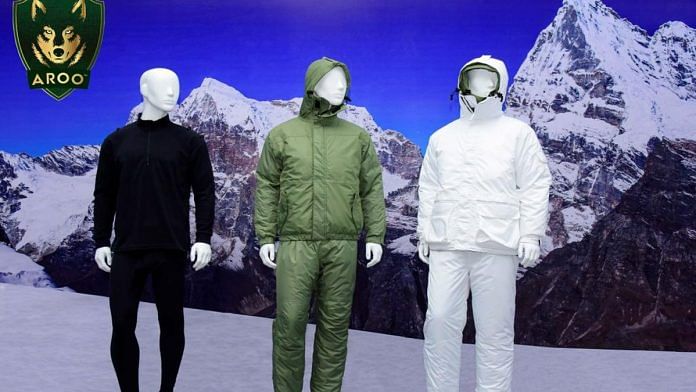New Delhi: India’s import dependence for extreme cold-weather clothing systems (ECWCS) — which equip soldiers to withstand extreme cold in high-altitude areas like Siachen — is now history.
Thanks to India’s first defence start-up specialising in defence clothing — AROO — soldiers are now being equipped with indigenous clothing systems.
ECWCS is a three-layer modular clothing system, worn together and designed to keep the body warm in temperatures of up to minus 50 degrees Celsius. It is worn by soldiers in high-altitude regions, including the Siachen Glacier, which is the highest battlefield in the world.
“It has been an honour for us to serve Indian soldiers through our indigenous solutions,” Munish Hinduja, one of AROO’S two founders, told ThePrint.
The first set of about 41,000 ECWCS was delivered in the second half of 2021.
With the Army confident about the product, they have re-ordered the indigenous ECWCS, rather than importing it from Switzerland, Vietnam or even Sri Lanka, as they earlier used to do.
While AROO does the research on the product, the manufacturing is handled by another company with which it has a tie-up. AROO, through its Bengaluru-based manufacturing partner, started the delivery of the latest set of ECWCS last week — its third since passing field trials in 2017.
“We can with pride comment that AROO ECWCS outperforms the imported clothing systems provided to the Indian Army. It also comes at a lower cost, thus providing savings to the Indian government. Furthermore, the Indian Army is no longer dependent on foreign companies for this life-saving apparel,” Hinduja added.
He said AROO is also in advanced field trials with the Indian Army for new extreme cold clothing (ECC) trousers, which provides protection in temperatures of up to minus 30 degrees Celsius.
Also read: IAF looks to ‘atmanirbhar’ start-ups to boost India’s swarm drone capability
Manufacturing tie-ups, earning on intellectual property rights
Explaining how the company operates, Hinduja said AROO is a creator of the product and develops it through its own research and development. It then ties up with an original equipment manufacturer (OEM), which bids for the Army tender.
AROO gets its money through fees for sharing its intellectual property rights over the product, Hinduja said.
“The manufacturing process designed by AROO is focused on creating a defect-free product. The manufacturing lines at our OEM’s facility combined with our quality standards and rigorous raw material testing conducted at our OEM’s in-house testing facility, provide us with real-time product performance, with an eye on the CLO value (warmth level) and waterproofness of the garment,” he added. “Our production supply outperforms foreign specifications by 20 per cent to 75 per cent on key performance parameters.”
According to Hinduja, AROO is already working on the next generation of such clothing for the Army and this time they have tied up with another company to bid for the project.
Hinduja said several foreign companies have approached them for collaboration for different kinds of clothing.
Deposing before the parliamentary standing committee on defence in late 2019, an Army officer had admitted that around 80 per cent of the essential three-layered special clothing with thermal insulation and other items essential for soldiers continue to be imported.
He had pointed out that attempts to domestically acquire such kits had not met with the “Army’s acceptable standards”.
(Edited by Poulomi Banerjee)
Also read: 3 Indian start-ups win IAF swarm drone competition, at least 2 in line for defence contracts






